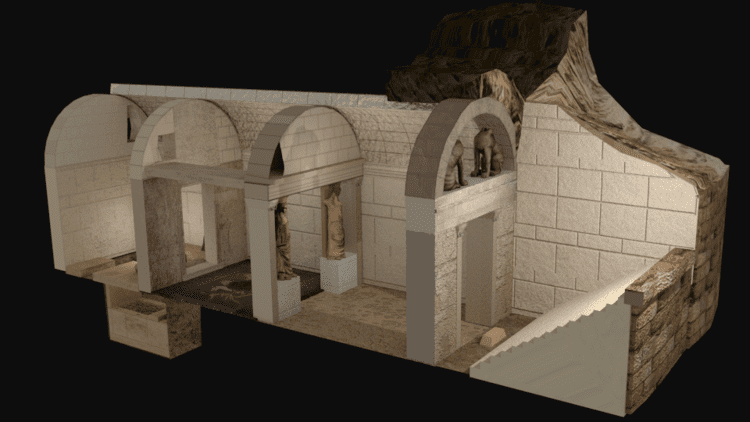Founded Late 4th century BC Height 23 m | Architectural style Classical architecture Archaeologist Katerina Peristeri | |
 | ||
Hours Closed today SaturdayClosedSundayClosedMondayOpen 24 hoursTuesdayOpen 24 hoursWednesdayOpen 24 hoursThursdayOpen 24 hoursFridayOpen 24 hours Similar Lion of Amphipolis, Archaeological Museum of Amphipolis, Tumulus, Heroon, Pangaion Hills | ||
The so-called Kasta Tomb, also known as the Amphipolis Tomb (Greek: Τάφος της Αμφίπολης), is an ancient Macedonian tomb that was discovered inside the Kasta mound (or Tumulus) near Amphipolis, Central Macedonia, in northern Greece in 2012 and first entered in August 2014. The first excavations at the mound in 1964 led to exposure of the perimeter wall, and further excavations in the 1970s uncovered many other ancient remains.
Contents
The recently discovered tomb is dated to the last quarter of the 4th century B.C. The tumulus is the largest ever discovered in Greece and by comparison dwarfs that of Philip II of Macedon, father of Alexander the Great, in Vergina. The excavation team, based on findings unearthed at the site, argued that the tomb was a memorial dedicated to the close friend of Alexander the Great, Hephaestion.
Identity
It is not yet known who is buried in the tomb, but the initial public speculation that it could be the tomb of Alexander the Great, because of its size and estimated cost of construction, was dismissed by the experts community when commenting on the published findings, as the available historical records mention Alexandria in Egypt as the last known location of Alexander's body; it has been supported instead, that a likely occupant could be either a wealthy Macedonian noble or a late member of the royal family.
The skeletal remains of five people were unearthed within a corresponding tomb, in the lower levels of the third chamber in November 2014. The dead of the burial are: A woman at the age of 60, two men aged 35–45, a newborn infant and a fifth person represented by minimum fragments. Further examination is underway with regard to the dating of the skeletal remains, as well as DNA cross examination between the dead of the burial as well as other skeletons from the neighboring tombs in the area.
At a press conference in the conference hall of the Aristotle University of Thessaloniki, Katerina Peristeri revealed the existence of three inscriptions apparently linking the tomb to Hephaestion, nobleman, General and close friend of Alexander the Great. The ancient Greek word "ΠΑΡΕΛΑΒΟΝ" (it means "received") is written in the inscriptions and next to it the monogram of Hephaestion.
Discovery
In the 1970s a building of 10m width was found on top of the centre of the mound, and is thought to have been a grave marker. This, together with other evidence, supported the likelihood of a large funerary complex within. The tumulus was also found to have covered earlier cemeteries with at least 70 graves from the nearby "Hill 133" settlement predating Amphipolis.
Finds
Archaeologists have made a number of important discoveries on the site since August 2014. Apart from the sheer size of the monument, which experts say bears the handprint of Dinocrates of Rhodes, the chief architect of Alexander the Great, archaeologists have so far unearthed:
Burials
The skeletal remains of 5 individuals were found:
The younger male showed signs of unhealed, possibly fatal wounds. Analysis of the skeletal remains is ongoing.
Precautions
In response to the magnitude of the finds, the authorities of Central Macedonia have requested and were granted a heavy 24-hour police guard of the dig site, and have also begun procedures to have the Kasta Tomb included in UNESCO's list of World Heritage Sites as a "top priority."
In popular culture
The board game Amphipolis, designed by Reiner Knizia, was published in 2015 and it is based on the location and findings of the Kasta Tomb.
